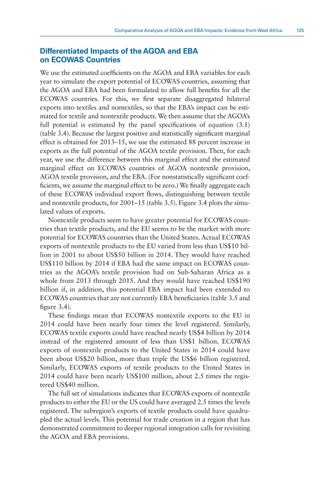Comparative Analysis of AGOA and EBA Impacts: Evidence from West Africa 125
Differentiated Impacts of the AGOA and EBA on ECOWAS Countries We use the estimated coefficients on the AGOA and EBA variables for each year to simulate the export potential of ECOWAS countries, assuming that the AGOA and EBA had been formulated to allow full benefits for all the ECOWAS countries. For this, we first separate disaggregated bilateral exports into textiles and nontextiles, so that the EBA’s impact can be estimated for textile and nontextile products. We then assume that the AGOA’s full potential is estimated by the panel specifications of equation (3.1) (table 3.4). Because the largest positive and statistically significant marginal effect is obtained for 2013–15, we use the estimated 88 percent increase in exports as the full potential of the AGOA textile provision. Then, for each year, we use the difference between this marginal effect and the estimated marginal effect on ECOWAS countries of AGOA nontextile provision, AGOA textile provision, and the EBA. (For nonstatistically significant coefficients, we assume the marginal effect to be zero.) We finally aggregate each of these ECOWAS individual export flows, distinguishing between textile and nontextile products, for 2001–15 (table 3.5). Figure 3.4 plots the simulated values of exports. Nontextile products seem to have greater potential for ECOWAS countries than textile products, and the EU seems to be the market with more potential for ECOWAS countries than the United States. Actual ECOWAS exports of nontextile products to the EU varied from less than US$10 billion in 2001 to about US$50 billion in 2014. They would have reached US$110 billion by 2014 if EBA had the same impact on ECOWAS countries as the AGOA’s textile provision had on Sub-Saharan Africa as a whole from 2013 through 2015. And they would have reached US$190 billion if, in addition, this potential EBA impact had been extended to ECOWAS countries that are not currently EBA beneficiaries (table 3.5 and figure 3.4). These findings mean that ECOWAS nontextile exports to the EU in 2014 could have been nearly four times the level registered. Similarly, ECOWAS textile exports could have reached nearly US$4 billion by 2014 instead of the registered amount of less than US$1 billion. ECOWAS exports of nontextile products to the United States in 2014 could have been about US$20 billion, more than triple the US$6 billion registered. Similarly, ECOWAS exports of textile products to the United States in 2014 could have been nearly US$100 million, about 2.5 times the registered US$40 million. The full set of simulations indicates that ECOWAS exports of nontextile products to either the EU or the US could have averaged 2.5 times the levels registered. The subregion’s exports of textile products could have quadrupled the actual levels. This potential for trade creation in a region that has demonstrated commitment to deeper regional integration calls for revisiting the AGOA and EBA provisions.


